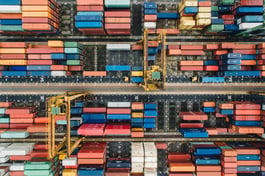Executive Summary
The Hidden Risk Costing U.S. Exporters Millions: Rail Billing Restrictions at Inland Ramps
For U.S. exporters of agriculture, food, and commodities, rail billing restrictions at inland ramps have emerged as one of the most disruptive - and costly - supply chain challenges. While many exporters focus on tracking containers in transit, the real issue often arises before shipments even leave the inland terminal.
Rail Visibility IS NOT Railcar Tracking
Understanding rail visibility requires looking beyond traditional railcar tracking. When vessel schedules change, rail schedules do not automatically adjust. Instead, ocean carriers often issue rail billing rejections, preventing certain containers from being in-gated at inland ramps.
The impact? Exporters are left scrambling to re-route shipments, often at the last minute, leading to costly delays.
The Financial Impact of Rail Billing Rejections
A common scenario many exporters face:
📦 "My inventory was ready, my trucks were scheduled… then the vessel schedule changed. Suddenly, I COULDN’T GET RAIL BILLING. My container was stuck - costing me at least $250 per container in storage and rehandling fees."
This situation is not an isolated event. Last year, U.S. exporters paid an estimated $306 million in extra storage and drayage fees due to rail billing rejections. These costs add up quickly, with per diem fees, emergency drayage, and vessel rollovers creating significant financial strain.
Introduction
Rail visibility is a crucial aspect of supply chain management for US exporters of containerized agriculture, food, and commodities. As global trade evolves, ensuring that exporters can monitor, manage, and optimize inland rail movements is key to reducing delays, minimizing costs, and preventing cargo disruptions. This article explains the significance of rail visibility and how it impacts exporters, particularly in relation to schedule reliability, stability, and accuracy.
This guide provides an in-depth explanation of rail visibility, including how inland rail disruptions affect exporters’ ability to meet cargo receiving windows and avoid rolled shipments. We will explore best practices, industry trends, and technologies that improve visibility across rail networks.
Why Rail Visibility Matters for Exporters
For US exporters of agriculture, food, and commodities, rail visibility is essential in ensuring that cargo reaches the port within the cargo receiving window. The cargo receiving window is defined as the period between the earliest return date (ERD) and the container yard (CY) cutoff date. Without clear visibility, exporters face challenges such as:
- Missed rail cutoffs leading to vessel rollovers
- Increased per diem and storage fees
- Chassis shortages and congestion at inland terminals
- Disruptions in multimodal transportation coordination
By leveraging real-time rail tracking and data-driven forecasting, exporters can improve logistics performance, reduce costs, and enhance customer satisfaction.
Key Aspects of Rail Visibility
1. Schedule Reliability
- Measures whether a rail carrier delivers containers on time to the designated port terminal.
- Exporters need reliable inland rail schedules to prevent shipment delays.
- Poor schedule reliability increases risks of demurrage and missed vessel cutoffs.
2. Schedule Stability
- Evaluates how consistently rail services operate over time.
- Exporters must consider rail reliability across different seasons, congestion levels, and rail carrier performance.
- Blank sailings and omitted rail services can disrupt shipment planning.
3. Schedule Accuracy
- Measures how well rail carriers forecast and adhere to planned schedules.
- Exporters rely on accurate forecasts to make informed logistics decisions.
- Sudden changes in rail schedules impact trucking, warehouse labor, and port congestion.
Challenges in Rail Visibility
1. Rail Billing Restrictions at Inland Ramps Caused by Vessel Schedule Changes
- Limited visibility into rail billing approvals - (i.e. - rail billing rejections due to ocean vessel schedule changes) - causes expensive, last-minute disruptions for in-gating at inland rail terminals.
- Exporters struggle to coordinate trucking and warehouse operations due to unpredictable ocean vessel schedules.
- Delays in rail schedules increase the risk of rolled shipments.
2. Limited Tracking Capabilities
- Some rail networks lack real-time container tracking, making it difficult to forecast arrival times at the marine terminal.
- Exporters must rely on manual updates, increasing operational inefficiencies.
3. Terminal Congestion and Chassis Shortages
- Congestion at inland ramps leads to storage bottlenecks, increasing dwell times.
- Chassis shortages delay container movement, affecting cargo cutoffs and vessel loading.
Scenario Planning
To mitigate the risks associated with rail disruptions, exporters must proactively plan for various scenarios that could impact containerized shipments. Below are key options and strategies:


Option 1: Rescheduling Loads at Storage or Processing Facilities
- Scenario: Containers are delayed due to ERD changes, but rescheduling at storage or processing facilities faces a 14 day backlog.
- Storage Usage: Agricultural, food, and commodity products require different storage solutions, including refrigerated storage for perishables, warehouse storage for dry goods, and grain elevators for bulk commodities.
- Cost Impact:
- Storage: $2,100 ($150/day × 14 days).
- Rehandling: $200.
- Per Diem: $700 ($50/day × 14 days).
- Total Cost Impact: $3,000.
- Reliability Weights: Ocean Carrier (30%), Rail Carrier (25%), Storage Facility (35%), Drayage (10%).
- Pros: Storage facilities provide buffer time to accommodate changing schedules.
- Cons: Limited capacity during peak export seasons.
Option 2: Alternate Storage or Processing Facility Usage
- Scenario: Products that do not meet shipment requirements are rerouted to an alternate facility for processing or storage until new market opportunities arise.
- Storage Usage: Products are frozen, processed, or held at alternate locations until new buyers or routes are secured.
- Cost Impact:
- Storage: $1,050 ($150/day × 7 days).
- Rehandling: $250.
- Per Diem: $350 ($50/day × 7 days).
- Drayage: $300.
- Total Cost Impact: $1,950.
- Reliability Weights: Ocean Carrier (20%), Rail Carrier (15%), Storage Facility (45%), Drayage (20%).
- Pros: Allows market flexibility when shipments cannot proceed as planned.
- Cons: Higher costs due to additional handling and specialized storage needs.
Option 3: Storage at Drayage Provider Yard
- Scenario: Containers are stored at a drayage yard for 5 days.
- Cost Impact:
- Storage: $500 ($100/day × 5 days).
- Rehandling: $200.
- Per Diem: $250 ($50/day × 5 days).
- Drayage: $150.
- Total Cost Impact: $1,100.
- Reliability Weights: Ocean Carrier (25%), Rail Carrier (20%), Storage Facility (15%), Drayage (40%).
- Pros: Cost-effective for short-term delays.
- Cons: Limited security and space for perishable goods.
Option 4: Cross-Town Rail Services to Off-Dock Terminals
- Scenario: Containers are moved to off-dock terminals with cross-town drayage.
- Cost Impact:
- Storage: $300 ($100/day × 3 days).
- Rehandling: $250.
- Per Diem: $150 ($50/day × 3 days).
- Drayage: $400.
- Total Cost Impact: $1,100.
- Reliability Weights: Ocean Carrier (20%), Rail Carrier (30%), Storage Facility (10%), Drayage (20%), Cross-Town Drayage (20%).
- Pros: Reduces congestion at main terminals.
- Cons: Higher drayage costs.
Option 5: Additional Free Time at Inland Ramps
- Scenario: Containers are stored for an additional 3 days at inland ramps.
- Cost Impact:
- Storage: $300 ($100/day × 3 days).
- Per Diem: $150 ($50/day × 3 days).
- Total Cost Impact: $450.
- Reliability Weights: Ocean Carrier (40%), Rail Carrier (35%), Storage Facility (10%), Drayage (15%).
- Pros: Minimal costs and avoids rerouting.
- Cons: Requires strong contractual negotiation.
Appendix: Considerations by Product Exported
This appendix summarizes key logistical considerations and mitigation strategies for different agricultural and food exports, focusing on inland rail visibility, storage, and transportation alternatives. These insights are designed to help U.S. exporters optimize costs, minimize delays, and ensure product integrity.
1. Cotton Exporters
Challenges:
- Dependence on inland rail ramps and vessel schedules.
- Frequent early return date (ERD) changes cause storage bottlenecks and rail billing rejections.
- High per diem charges and rehandling costs when containers are delayed.
Mitigation Strategies:
✅ Storage at Drayage Provider Yards: Low-cost alternative when facing short-term delays.
✅ Alternate Warehouse Usage: Secondary storage options help avoid long delays but increase costs.
✅ Cross-Town Rail Services: Moves cotton to off-dock terminals to prevent port congestion.
✅ Negotiating Additional Free Time: Reduces storage costs but requires carrier agreement.
2. Soybean Exporters
Challenges:
- Bulk-to-container transitions require specialized storage.
- Delays at inland ramps cause per diem fees and risk missing vessel cutoffs.
- Limited capacity in grain elevators during peak export seasons.
Mitigation Strategies:
✅ Storage at Grain Elevators: Provides drying and bulk storage but limits flexibility.
✅ Transloading Facilities: Allows faster movement but adds drayage costs.
✅ Alternate Storage Facilities: Enables market flexibility but increases handling risks.
3. Meat Exporters
Challenges:
- Strict cold-chain requirements for fresh and frozen meat.
- ERD changes result in product spoilage risks.
- High costs for extended storage at refrigerated warehouses.
Mitigation Strategies:
✅ Cold Storage Facilities: Ensures temperature control but faces capacity constraints.
✅ Alternate Cold Storage Facilities: Allows rerouting to frozen storage to maintain value.
✅ Extended Free Time at Inland Ramps: Reduces reliance on cold storage but requires carrier agreement.
4. Feed Ingredients Exporters
Challenges:
- Containerized bulk shipments require specialized handling.
- ERD delays lead to increased storage costs and market uncertainty.
- Limited transloading capacity during peak export periods.
Mitigation Strategies:
✅ Storage at Transloading Facilities: Adds flexibility for containerized bulk shipments.
✅ Alternate Transloading Facilities: Helps reduce delays but increases drayage costs.
✅ Negotiated Free Time at Inland Ramps: Minimizes reliance on third-party storage.
5. Dairy Exporters
Challenges:
- Highly perishable fluid milk and short-shelf-life dairy products require strict cold chain management.
- Storage delays lead to product degradation and financial losses.
- Peak season congestion limits availability of cold storage.
Mitigation Strategies:
✅ Cold Storage Facilities: Provides controlled environments but faces availability constraints.
✅ Alternate Cold Storage Facilities: Allows conversion of fluid milk to frozen products for market flexibility.
✅ Extended Free Time at Inland Ramps: Low-cost alternative for frozen dairy but requires carrier coordination.
6. Fruits & Nuts Exporters
Challenges:
- Perishable fruits (e.g., cherries, citrus) require temperature-controlled storage.
- Dried fruit and nuts have longer shelf life but require secure storage.
- Vessel schedule changes increase risks of spoilage and financial loss.
Mitigation Strategies:
✅ Cold Storage for Fruits & Dry Warehousing for Nuts: Maintains product quality but is costly during peak season.
✅ Alternate Storage Facilities: Allows freezing or repackaging for secondary markets.
✅ Cross-Town Rail Services: Helps avoid port congestion but increases drayage expenses.
✅ Additional Free Time at Inland Ramps: Cost-effective for nuts and dried fruits but not viable for perishables.
Conclusion
Each agricultural export category presents unique logistical challenges, requiring tailored strategies for rail visibility, storage, and cost control. Proactive risk management, flexible storage solutions, and strong carrier negotiations can enhance supply chain efficiency and reduce financial exposure for U.S. exporters.
This guide provides a framework for leveraging rail visibility tools, advocating for rail carrier accountability, and integrating data-driven decision-making into logistics operations.





Leave a Comment